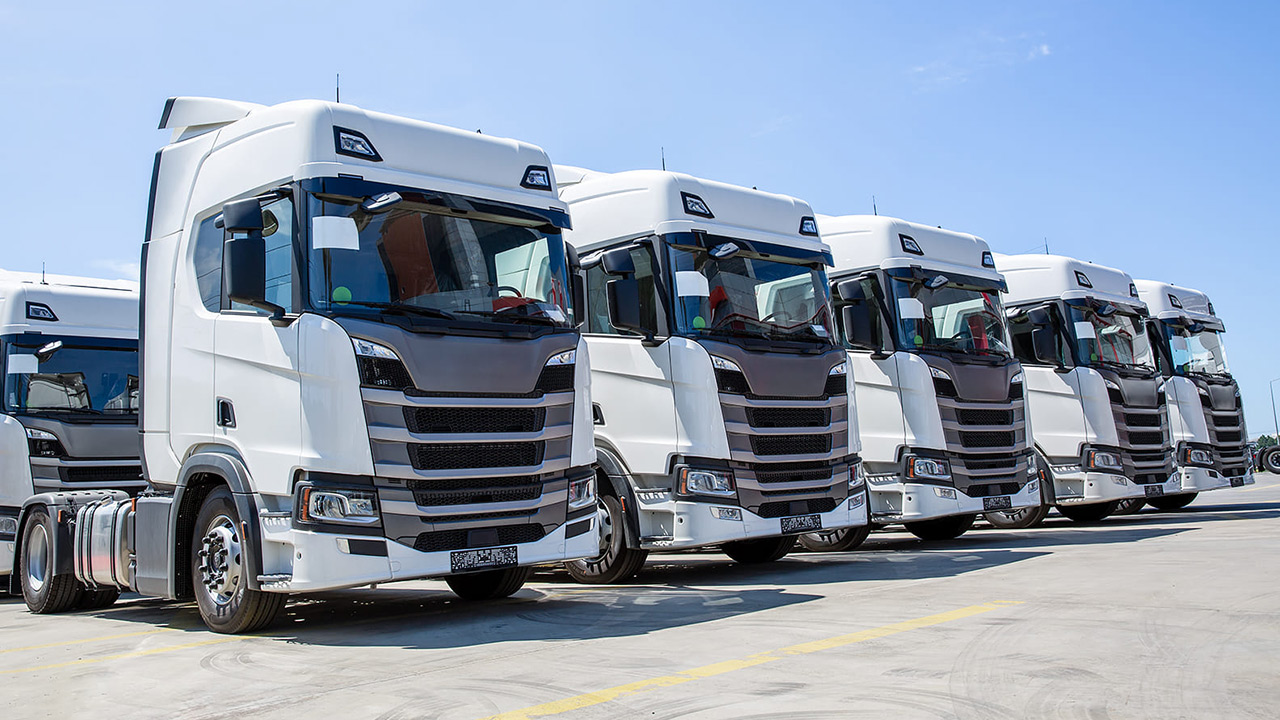The fleet management industry presents a significant growth opportunity for telematics service providers. Valued at $19.47 billion in 2020 and projected to surge to $52 billion by 2030, with a robust annual growth rate of 10.6%, this sector demands competitive and comprehensive solutions.
In this environment, efficient logistics isn't just a nice-to-have; it's the engine that drives business competitiveness. As supply chains become increasingly complex and customers demand ever-faster service, a well-optimized logistics system becomes a strategic weapon.
This creates a strong demand for robust logistics fleet management solutions, making it a key area for telematics service providers to excel. By offering such comprehensive solutions, service providers can expand their service portfolio and attract new clients.
This article outlines the essentials of logistics fleet management, focusing on its benefits for telematics providers, key components to offer, common challenges in the market, and the role of software solutions in achieving operational excellence for your clients.
What is fleet management in logistics?
Logistics fleet management is a key part of supply chain operations, focusing on the management of a company's transportation vehicles. It's not simply about owning trucks — it encompasses everything from buying and maintaining vehicles to planning routes and managing drivers. All with the goal of delivering goods on time and with maximum efficiency.
Who needs logistics fleet management?
Think of any industry where efficient movement of goods, services, or people is critical.
Telematics service providers can leverage logistics fleet management solutions to cater to a diverse range of clients, including:
- Transportation companies: Offer solutions that empower route optimization and cost reduction.
- Delivery services: Provide tools to ensure timely deliveries, and maximize customer satisfaction.
- E-commerce businesses: Equip clients to handle high order volumes, streamline last-mile delivery, and optimize fulfillment for faster delivery and reduced costs.
- Retailers: Empower customers to maintain efficient supply chains.
- Manufacturers: Offer solutions that optimize transport of raw materials and finished products.
- Construction companies: Provide tools to move heavy equipment and materials efficiently for timely project completion.
- Public transportation: Prioritize passenger safety and comfort through optimized routes, efficient schedules, and reliable vehicle management.
- Healthcare providers: Deliver solutions that facilitate reliable medical supply delivery and patient transport.
- Utility companies: Offer tools to streamline service vehicle operations for efficient infrastructure maintenance and customer support.
- Government and municipalities: Provide solutions that support effective public service and emergency response.
- Agricultural businesses: Equip clients to optimize transport of crops, livestock, and equipment.
- Logistics providers: Offer solutions that enable reliable, cost-effective transport solutions.
Benefits of logistics fleet management for businesses worldwide
If logistics fleet management is effective, it comes with numerous advantages for your clients and can boost their business performance in multiple aspects. Here are some of the key benefits:
- Cost reduction: Logistics fleet management tackles this issue by optimizing routes and vehicle usage, reducing fuel consumption and maintenance expenses. Additionally, it helps businesses negotiate better deals with suppliers and service providers.
- Increasing efficiency: Fleet management systems in logistics improve route planning, scheduling, and vehicle use. This leads to faster delivery times, reduced travel distances, and optimized resource allocation.
- Enhanced customer service: Today, on-time delivery is a key driver of customer satisfaction. Logistics fleet management ensures timely deliveries by providing accurate tracking information, helping businesses meet customer expectations and strengthen loyalty.
Fact: In e-commerce, fast delivery is a major decision-making factor, with 25% of consumers willing to pay a premium for same-day or instant delivery.
- Improved safety: Logistics fleet management includes regular maintenance schedules, driver training programs, and real-time vehicle and driver monitoring. These measures help reduce the risk of accidents, minimize vehicle wear and tear, and ensure regulatory compliance.
- Data-driven insights: Fleet management systems collect valuable data on vehicle performance, driver behavior, and operational efficiency. Analyzing this data helps businesses spot trends, make informed decisions, and implement strategic improvements.
- Extended vehicle lifespan: Regular maintenance and timely repairs prolong vehicle lifespan, reducing the need for costly replacements and minimizing unexpected downtime.
- Environmental sustainability: By optimizing routes and promoting fuel-efficient or electric vehicles, logistics fleet management helps reduce fuel consumption and lower emissions, contributing to sustainability efforts.
- Overall business growth: A well-managed fleet supports business expansion by enabling the rapid adoption of new transportation technologies, streamlined maintenance, and improved performance.
Key components of logistics fleet management
To provide impactful logistics and fleet management solutions, telematics service providers need to leverage a suite of interconnected components. Their harmony ensures efficient and reliable transportation operations.
1. Vehicle selection
Choosing the right types and number of vehicles is essential for optimizing fleet performance. As a telematics provider, you can offer tools and data to help clients make strategic decisions, considering factors such as:
- Vehicle capacity
- Fuel efficiency
- Maintenance costs
- Suitability for specific routes or types of cargo
Accurate vehicle selection enhances cost and operational efficiency, primarily through better load management. For example, businesses that optimize their fleet choices can significantly reduce fuel consumption. Additionally, investing in fuel-efficient and low-emission vehicles contributes to the sustainability efforts.
Fact: In the UK, logistics companies are increasingly adopting sustainable technologies to comply with national and international regulations. Many are also defining their next steps toward achieving net-zero emissions.
Finally, selecting the appropriate vehicles ensures compliance with emissions, safety, and roadworthiness regulations. This helps businesses avoid potential fines and operational disruptions.
Tips for vehicle selection for fleet owners:
- Assess client needs, delivery schedules, and routes.
- Evaluate vehicle options to ensure they align with operational requirements.
- Weigh long-term costs and benefits of each option.
- Look at emissions and fuel use; consider electric or alternative fuel vehicles.
- Use fleet management software to track performance and optimize vehicle usage.
2. Maintenance management
Maintenance management involves the regular servicing, inspection, and repair of fleet vehicles to ensure they remain safe, reliable, and operating at optimal efficiency. As a telematics provider, you can offer solutions that automate maintenance scheduling, track vehicle health, and predict maintenance needs.
Fact: A well-maintained fleet minimizes downtime and can lower accident-related costs by up to 15%. Additionally, effective maintenance management improves fuel efficiency by more than 10%, leading to significant cost savings.
Tips for effective maintenance management for fleet owners:
- Implement a preventive maintenance schedule based on manufacturer recommendations, vehicle usage, and mileage.
- Employ fleet management software such as Wialon to track maintenance schedules, vehicle history, repair costs, and more.
- Make sure drivers and maintenance personnel are trained to identify and report issues promptly.
3. Route optimization
Planning the most efficient paths for fleet vehicles is essential for minimizing travel time, fuel consumption, and operational costs. Telematics service providers can empower clients with advanced route optimization software that integrates seamlessly with GPS tracking and provides dynamic routing capabilities.
Fact: In parcel delivery, the last mile accounts for nearly 50% of total delivery costs, including pickup, transport, and sorting. Given its high impact, optimizing routes is essential for cost control. Beyond cost savings, effective route planning helps reduce fuel consumption and unnecessary mileage, lowering both fuel expenses and environmental impact.
Tips for route optimization for fleet owners:
- Use advanced fleet management solutions such as Wialon, which factors in traffic patterns, road conditions, vehicle capacity, and delivery windows. This reduces manual work, saves time, and minimizes human errors.
- Implement dynamic routing capabilities. Adjust routes in real-time based on changing conditions such as traffic or weather.
- Integrate route optimization software with GPS tracking systems for better visibility and control.
4. Driver management
Hiring, training, monitoring, and motivating drivers are all essential aspects of ensuring they operate vehicles safely and efficiently. Service providers can offer a range of tools to support clients in this area, including solutions for driver monitoring and performance evaluation.
Companies that implement comprehensive driver training programs see fewer accidents and traffic violations. By leveraging telematics, fleet operators can monitor and improve driving habits, leading to fuel savings and increased productivity. As a result, businesses can reduce the need for additional hires.
Fact: Driver management solutions also help achieve up to 95% compliance with regulations and reduce overspeeding by as much as 90%. Additionally, organizations that provide regular training and incentives for safe driving experience higher driver retention rates.
Tips for driver management for fleet owners:
- Implement a rigorous hiring process to select qualified drivers with good safety records.
- Provide regular training on safe driving practices, vehicle handling, and fuel-efficient driving.
- Use telematics to monitor driver behavior, such as speeding, harsh braking, and idling. Software such as Wialon enhances driver safety and efficiency worldwide.
- Offer incentives for safe driving and fuel-efficient practices to encourage responsible behavior.
5. Telematics and GPS tracking
Telematics leverages GPS technology and onboard diagnostics to monitor the location, movement, and performance of fleet vehicles in real time. For service providers, this presents an opportunity to offer robust solutions that provide real-time data and valuable insights into the fleet.
Tips for telematics and GPS tracking for fleet owners:
- Install GPS tracking devices in all vehicles to monitor location and route adherence.
- Use telematics systems. Solutions such as Wialon monitor vehicle performance metrics. Think engine health, fuel usage, and tire pressure.
- Analyze telematics data to identify trends, optimize routes, and schedule maintenance proactively.
6. Fuel management
Monitoring and optimizing fuel consumption is a key aspect of fleet management, aimed at reducing costs and minimizing environmental impact. Telematics service providers can play a crucial role in this area by offering fuel management tools that integrate seamlessly with telematics data to track fuel consumption, identify inefficiencies, and support fuel-efficient driving practices.
Fact: Fuel is one of the largest expenses in transportation fleet management. Effective fuel management reduces costs by 23%. It also minimizes environmental impact, driver accidents, and tickets for driving violations.
Tips for fuel management for fleet owners:
- Implement fuel cards and telematics to track fuel usage and identify inefficiencies. Idling alone can account for 5% to 8% of total fuel consumption.
- Train drivers in fuel-efficient driving techniques, such as minimizing idling and maintaining steady speeds.
- Regularly maintain vehicles to make sure they operate at peak fuel efficiency.
7. Compliance and safety
Ensuring that fleets adhere to all relevant laws and regulations while maintaining high safety standards is crucial. Service providers can offer valuable solutions that automate compliance reporting, track safety metrics, and help clients stay updated on regulatory changes.
Staying compliant helps prevent legal issues and financial penalties while also protecting drivers, vehicles, and cargo. This leads to a lower risk of accidents and injuries. Additionally, a strong commitment to safety and compliance enhances client trust and strengthens the company’s reputation in the industry.
Tips for compliance and safety for fleet owners:
- Stay updated on relevant local, state, and federal regulations affecting fleet operations.
- Establish and enforce strict safety protocols, including regular safety training and vehicle inspections.
- Maintain accurate records of compliance checks, inspections, and safety training sessions.
8. Data analytics and reporting
Gathering, analyzing, and using the fleet data is essential for optimizing resources and making informed decisions. Telematics service providers can offer comprehensive data analytics and reporting tools that empower clients to track KPIs, generate custom reports, and identify areas for continuous improvement.
By leveraging data, fleet managers can identify inefficiencies, enhance performance, and reduce costs. Analyzing metrics such as fuel consumption, maintenance expenses, and operational costs helps uncover opportunities for savings and efficiency improvements.
Additionally, data-driven insights support better forecasting, budgeting, and KPI monitoring, leading to improved operational effectiveness.
Tips for data analytics and reporting for fleet owners:
- Use software that offers comprehensive analytics and reporting features to track KPIs.
- Generate custom reports to monitor fuel consumption, driver performance, maintenance costs, and more.
- Use data analytics to identify areas for continuous improvement and implement necessary changes.
9. Communication systems
In fleet management, communication systems leverage technology to keep drivers, dispatchers, and fleet managers connected in real time. Service providers can offer communication solutions that facilitate real-time interaction between drivers, dispatchers, and fleet managers.
Good communication reduces errors, improves coordination and response times, and helps manage emergencies such as breakdowns or accidents. It also provides real-time updates and instructions, helping keep drivers safer on the road.
Tips for communication systems for fleet owners:
- Equip vehicles with two-way radios for direct communication between drivers and dispatchers.
- Use mobile apps that allow drivers to receive updates, report issues, and access route information.
- Implement a centralized communication platform to streamline communication and document exchanges.
10. Customer service
In fleet management, customer service ensures transportation meets or exceeds expectations for:
- Timeliness
- Reliability
- Quality
Meeting these expectations fosters repeat business, positive reviews, and long-term relationships. Telematics service providers can empower clients to achieve this by offering tools and features that enhance customer service, such as real-time tracking for customers, delivery notifications, and feedback collection.
Tips for customer service for fleet owners:
- Optimize routes and maintain vehicles to ensure deliveries are made on time and in perfect condition.
- Collect and analyze customer feedback to identify areas for improvement.
- Keep customers informed about the status of their shipments and any potential delays.
11. Sustainability practices
Sustainability practices involve adopting eco-friendly strategies to minimize the environmental impact of fleet operations. Telematics service providers can play a crucial role in enabling clients to achieve this by offering solutions that help them track and report on their sustainability efforts, optimize fuel consumption, and promote eco-friendly driving practices.
A sustainable fleet reduces carbon emissions, ensures compliance with environmental regulations, and meets the rising demand for green logistics. It also helps companies lower fuel costs and enhance their corporate image.
Fact: In the US, more than 60% of consumers prefer brands that demonstrate sustainable business practices, making eco-friendly initiatives a key competitive advantage.
Tips for sustainability for fleet owners:
- Transition to alternative-fuel vehicles, such as electric, hybrid, or natural gas-powered models. Electric vehicles can cut greenhouse gas emissions by up to 36% compared to conventional vehicles.
- Train drivers in eco-friendly driving practices to reduce fuel consumption and emissions.
- Invest in carbon offset initiatives to neutralize the environmental impact of fleet operations.
Fast track to logistics fleet management success
Modern fleet management platforms cover most logistics needs and offer essential features such as:
- Real-time tracking
- Route optimization
- Comprehensive data analytics
Such software monitors vehicle performance, streamlines operations, and enables data-driven decision-making to enhance overall efficiency.
Take Wialon’s delivery management solution. It simplifies logistics and delivery tasks, including transportation arrangements, route planning, and cost optimization. The platform features a web version for dispatchers to manage orders, plan routes, and monitor operations, as well as a mobile app for drivers and other field employees.
Wialon: Empowering logistics excellence with telematics solutions
Offering effective logistics fleet management solutions is no longer a luxury; it's a strategic imperative for telematics service providers. By embracing these 11 key components and leveraging the power of technology, you can position yourself as a leader in the industry, driving innovation, enhancing your service offerings, and empowering your clients to achieve sustainable success in the ever-evolving world of logistics.
Wialon provides real-time tracking, route optimization, and data analytics, allowing businesses to monitor performance, streamline workflows, and make informed decisions. With both a web interface for dispatchers and a mobile app for drivers, Wialon simplifies logistics and delivery operations.
Now is the time to leverage the right fleet management solution to empower businesses worldwide, combining technology with strategic planning. In logistics, continuous improvements lead to long-term success.
Ready to get started with Wialon? Get in touch with us at sales@wialon.com.
Looking for a reliable telematics service partner? Check the Wialon partner map and pick the expert in your region.



.jpg)

